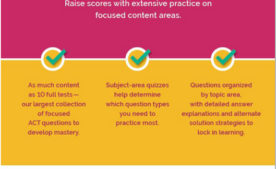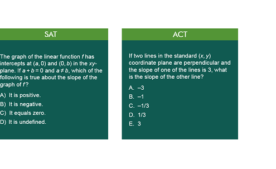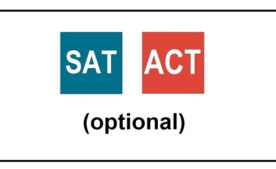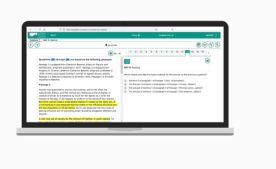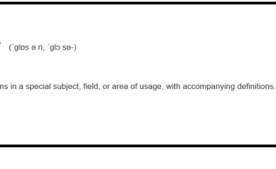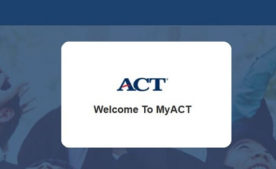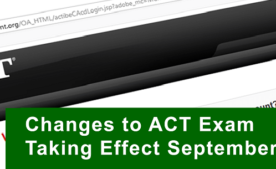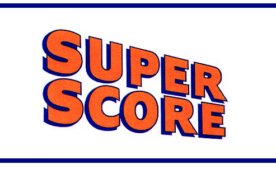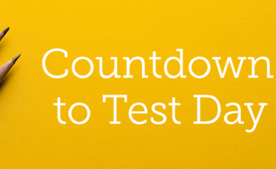Understand the Lingo
Navigating college admissions is a complicated process, especially when you’re going through it for the first time with your teenager. We hope that this glossary will help you make sense of some of the terminology.
ACCEPTANCE RATE – The percentage of students admitted to an incoming class year, based on the total number of applicants a college/university received for that year. (Acceptance Rate = # of accepted candidates/# of candidate applicants). View a sampling of admission statistics at selected colleges.
ACCOMMODATIONS – Students with documented disabilities, IEP or 504 plans, other school-based plans or who are English Learners may be eligible for accommodations to support their test taking experience. The most common accommodation is time and a half. Families work with school counselors to assemble the required documentation and submit a request for accommodation. Each testing company has its own request submittal, approval, and appeals process.
ACT – The ACT is one of the two most common standardized tests for college admissions in the U.S. (the other is the SAT). The ACT is scored on a scale of 1 – 36. It is administered by ACT, a nonprofit organization of the same name. Some school districts use the ACT as a State-mandated assessment of high school student learning. The ACT consists of four sections, which they call “tests”, including English, Reading, Math, and Science.
ACT ENGLISH – One of the 4 sections on the ACT, the ACT English test is a 75-question, 45-minute test. It consists of three single and one paired passage, each followed by multiple-choice questions.
ACT MATH – One of the 4 sections on the ACT, the ACT Math test is a 60-question, 60-minute test. Students may use a calculator to solve the problems, which range in content from pre-algebra through basic trigonometry.
ACT READING – One of the 4 sections on the ACT, the ACT Reading test is a 40-question, 35-minute test. It typically contains 3 single passages and 1 paired passage with 10 questions per passage. Passages are 700-900 words long. The first passage is a prose fiction or literary narrative piece, and the other three are on social science, humanities, and natural science, in that order.
ACT SCIENCE – One of the 4 sections on the ACT, the ACT Science test is a 40-question, 35-minute test. While it contains passages using scientific language and reasoning, it is not designed as a scientific achievement test.
ACT STUDENT REPORT (ACT SCORE REPORT) – The ACT’s Student Report is issued online when ACT scores are posted. It includes a student’s Composite Score and individual Test Scores as well as the corresponding US and Sate Ranks indicating how these scores compare to other test-takers’, and a detailed breakdown by category. If the student has taken the ACT more than once, the online ACT Score Report also gives Superscore information.
AP EXAMS – These are optional exams that students may choose to take, most commonly as the capstone of a yearlong AP (“Advanced Placement”) class taught at schools. Some colleges use AP exam scores for placement or to waive prerequisites, while the more selective institutions may consider them as part of admission decisions.
CALCULATOR POLICIES – Both the College Board and ACT publish distinct policies on their websites, which describe the type of calculator (make and model) and when it may be used while taking the tests. See the ACT Calculator Policy and the SAT Calculator Policy.
COLLEGE BOARD – the nonprofit organization which develops and administers the SAT tests. The College Board also develops the course curriculum and certifies schools to teach and administer the AP exams.
COMPOSITE SCORE (ACT) – Your composite score and your individual test scores are what matters most to colleges. The composite score is the average of your 4 test scores (English, Reading, Math, and Science).
COMMON APP – The Common Application (Common App) is a college application management tool that is accepted by over 800 schools. It saves time by enabling students to fill out an application form once and make it available to send to multiple schools electronically. The Common App also helps students track deadlines and requirements. Generally, it opens on August 1 for students who plan to start school in the following fall.
COALITION APP – The Coalition App (“Coalition” for Access, Affordability, and Success) is relatively new with 150 member schools that accept applications submitted using it. Member schools must meet the Coalition’s requirements for making college affordable and ensuring students graduate on time. Generally, it opens on August 1 for students who plan to start school in the following fall.
CSS – The CSS Profile is an online application that collects information used by nearly 400 colleges and scholarship programs to award non-federal aid. (For federal aid you must complete the FAFSA.)
EFC (Expected Family Contribution) – This is an estimate of how much the student (or parent) is/are able to pay for college. The EFC is used to determine an applicant’s eligibility for need-based aid, and is often used in state and college-based financial aid decisions. Many colleges provide an EFC calculator on their websites. The FAFSA provides an estimated family contribution after you’ve completed the application. The EFC tool is also available on many financial aid websites.
EXPERIMENTAL QUESTIONS – Test makers add experimental questions (also know as “Section 5”) to their official tests as a way of gathering statistical data to ensure the tests’ validity and that they can be relied on to guarantee fairness across demographic subgroups. Experimental questions will not count toward a student’s score and are often not made known to students during the test. For details about how and where these questions are in the standardized tests, read How to Answer Experimental Questions on ACT and
FAFSA (Free Application for Federal Student Aid) – This is an online application that families must use to apply for federal financial aid to pay for college. However, it is also used by many states, colleges, and universities in making their financial aid decisions.
GRAPHING CALCULATOR – These devices (for example, the Texas Instruments TI-84) help students perform statistical and algebraic functions easily. Students are permitted to use approved graphing calculators on a portion of the SAT Math and on the entire ACT Math sections. Each testing company publishes its list of approved graphing calculators on its website. Here are links to the ACT Calculator Policy and the SAT Calculator Policy.
NATIONAL MERIT SCHOLARSHIP PROGRAM – High School Juniors who take the PSAT/NMSQT (National Merit Scholarship Qualification Test) are automatically entered into this competition. The PSAT Score Report includes a number called the Selection Index Score. A student must achieve a minimum Selection Index Score cutoff for the state in which they reside, as well as attain other academic and SAT/ACT score requirements in order to be eligible. We’ve provided more information here: PSAT / NMSQT 101: What You Need to Know.
PRACTICE TESTS – Practice tests are a crucial component of any test prep program, and are especially important right at the start of the college process to decide between the ACT and SAT. The purpose of taking practice tests at the outset is to give students exposure to the question types, formats, and pacing of the exams. Practice tests are an important tool in monitoring the progress of test preparation.
PREACT – The ACT’s analog to the PSAT, the PreACT is offered as a way to practice and predict performance on the ACT. Schools may offer it to students in grades 9-12 at any time of year. The PreACT is not associated with the National Merit Scholarship.
PSAT/NMSQT – The College Board’s Preliminary SAT/National Merit Scholarship Qualifying Test is administered to high school students in the fall of junior year. It’s offered as a way to practice the SAT, in which students with high scores qualify for National Merit Scholarships. PSAT scores are not viewed by college admissions officers. When you have your PSAT score report, we have suggestions for Interpreting Your PSAT Score Report.
SAT – The SAT is one of the two most common standardized tests for college admissions in the U.S. (the other is ACT). The SAT is scored on a scale of 400 – 1600. It is administered by The College Board, a nonprofit organization. Some school districts use the SAT as a State-mandated assessment of high school student learning. The SAT consists of four sections, including Math with calculator, Math without calculator, Reading, and Writing & Language.
SAT MATH – The Math portion of the SAT is divided into two sections: a 25-minute, 20-question section with no calculator allowed and a 55-minute, 38-question section on which students may use a calculator. The two Math sections together are worth 800 points (50% of your score). The content covers pre-algebra through trigonometry. You might be interested in reading our comparison of the SAT Math vs ACT Math.
SAT READING – One of the four sections of the SAT, the SAT Reading section has 52 questions and is 65 minutes long. It accounts for half of the Evidence-Based Reading & Writing score with 400 available points. It consists of four single and one paired passage, each followed by multiple-choice questions.
SAT SCORE REPORT – The SAT Score Report is issued online when SAT scores are posted. It includes a student’s Total Score, Section Scores, Essay Scores (if relevant), and Cross-Test Scores, as well as percentiles indicating how these scores compare to other test-takers’.
SAT WRITING & LANGUAGE – One of the four sections of the SAT, the SAT Writing & Language section has 44 questions and is 35 minutes long. It accounts for half of the Evidence-Based Reading & Writing score with 400 available points. It consists of 4 passages with multiple-choice questions to test a student’s knowledge of Standard English Conventions as well as his or her skill level with Expression of Ideas.
SAT-ACT SCORE CONCORDANCE – The College Board and ACT collaborated to develop a concordance table as a tool to convert between SAT and ACT scores and show equivalencies. This helps colleges compare applicants who’ve taken different tests and also helps students determine which test to prepare for (based on practice or diagnostic scores) and which results to send.
SCHOOL DAY TESTING – The College Board and ACT offers schools, districts, and states the option to administer the SAT or ACT during the school day. This policy aims to improve access and equity; it has grown in popularity due to the coronavirus pandemic.
SCORE CHOICE – A reporting policy set by the College Board and the ACT individually, Score Choice gives students control over which tests colleges will see. The SAT sends all scores by default unless you choose to activate the Score Choice option. The ACT sends only scores you request. Note that some schools do not follow Score choice policies and will request all test scores.
SECTION SCORE SAT – SAT takers receive two Section Scores, one for Math and one for Evidence-Based Reading and Writing, each worth 200-800 points. The Total Score is the sum of the two Section Scores.
SECTION SCORE ACT – The ACT refers to each of its four sections as individual “tests.” ACT takers receive four individual test scores, one each for English, Math, Reading, and Science, and one composite score. Test scores and the composite are each worth 1-36 points. The composite score is the mathematical average of the four individual test scores, rounded if necessary (21.25 = 21, 21.5 = 22).
SUPERSCORING – Colleges with this admissions policy will consider the best section score from each test you submit. If, for example, you score better on Math on the December SAT and better on Verbal in March, you can submit reports from both dates to a college that superscores to maximize your overall SAT score for their records. Note: If you choose to superscore, you must send the complete score report from each relevant test date. Both the SAT and the ACT can only be reported as a whole.
TEST BOOKLETS (QAS/TIR) – After receiving their score from an official SAT or ACT, students may want to review the questions and answers and compare it against their own responses. The testing companies offer this “service” as a separate option for purchase during the test registration process and within a limited window following the test date. The College Board’s QAS (Question and Answer Service) is typically available for the October, March and May test dates and is delivered online. The ACT’s TIR (Test Information Release) is available for its December, April, and June dates and is delivered by mail. Note: The College Board’s SAS (Student Answer Service) does not include the questions and is not as useful.
TEST-FLEXIBLE – A college or university with a test-flexible admissions policy accepts a broader variety of standardized test scores with an application. This may include AP, IB, or SAT Subject test scores in addition to SAT and ACT scores. Which tests are accepted will vary by institution.
TEST-OPTIONAL – A college or university with a test-optional admissions policy does not require an SAT or ACT score with an application, but will consider those scores if submitted. Institutions with this policy generally prioritize other aspects of the application, such as GPA, personal essay, and recommendations, over standardized test scores.
TEST BLIND – A college or university with a test-blind admissions policy does not accept standardized test scores with an application. Note: Some of these institutions may still require SAT or ACT scores for certain programs, such as nursing, and students may also need such scores to apply for certain scholarships or grants.
TEST PREPARATION – The process of preparing for a standardized test. Elements of test prep with Summit include building a strong foundation in the material, gaining familiarity with the test questions, and practicing on timed, real tests mimicking test-day conditions.
TESTING STRATEGY – A set of best practices for test-taking that will help you make the most of the allotted time and maximize your score. Pacing, process of elimination, working backward, and question type recognition are types of testing strategies. Having an arsenal of tools at their disposal puts students in control of the test. Read more about our approach to test prep tutoring.
TEST PLAN – A test plan determines the choice of test, the target test date, and the timeline for preparation. The best test plans are tailored to each individual student’s goals, current preparedness, and personal commitments.
WRISTWATCH POLICIES – Both the College Board and the ACT prohibit smart watches and any other type of wristwatch that can be used to record or transmit information. Watches with audible alarms are also prohibited. See the College Board’s Phone & Electric Device Policy and the ACT’s What to Bring On Test Day list for more.






